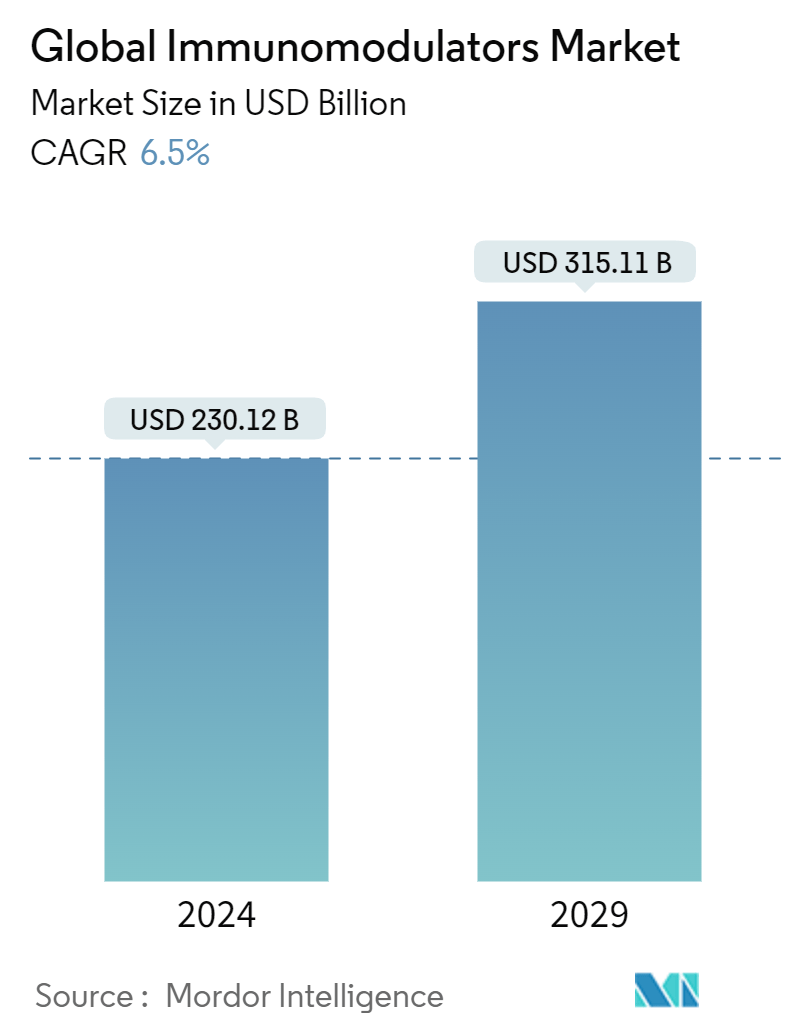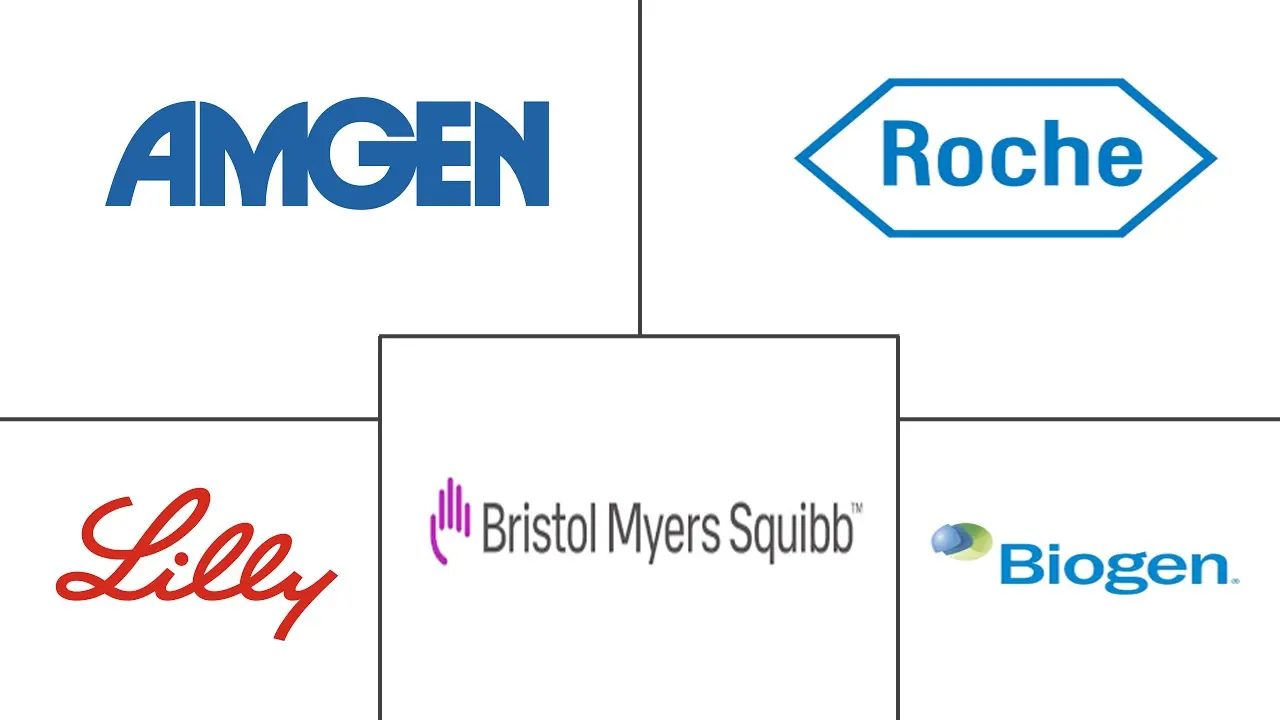Market Size of Global Immunomodulators Industry

| Study Period | 2019 - 2029 |
| Market Size (2024) | USD 230.12 Billion |
| Market Size (2029) | USD 315.11 Billion |
| CAGR (2024 - 2029) | 6.50 % |
| Fastest Growing Market | Asia-Pacific |
| Largest Market | North America |
| Market Concentration | Medium |
Major Players
*Disclaimer: Major Players sorted in no particular order |
Immunomodulators Market Analysis
The Global Immunomodulators Market size is estimated at USD 230.12 billion in 2024, and is expected to reach USD 315.11 billion by 2029, at a CAGR of 6.5% during the forecast period (2024-2029).
Immunomodulators play a pivotal role in contemporary pharmacotherapy, designed to adjust or enhance the immune system's response. These drugs are crucial for addressing a range of conditions, including autoimmune disorders, cancers, and infectious diseases. Recently, the global market for immunomodulators has expanded significantly, fueled by the increasing prevalence of chronic diseases, breakthroughs in biopharmaceutical technologies, and a heightened demand for targeted and personalized therapies. For instance, the American Cancer Society's "Cancer Facts and Figures 2023," published in January 2023, forecasts approximately 1.9 million new cancer diagnoses in 2023. Specifically, prostate cancer cases are projected at 288,300, lung cancer at 238,340, and female breast cancer at 300,590. Given this rising cancer burden, a surge in demand for advanced cancer treatments is expected, likely propelling the immunomodulators market during the forecast period.
The rising prevalence of autoimmune diseases further fuels the growth of the immunomodulators market. Autoimmune disorders, where the immune system mistakenly attacks healthy tissues, are becoming more common. The National Institutes of Health (NIH) estimates that around 24 million people in the U.S. are affected each year. Researchers are actively exploring new immunomodulators for managing these diseases. A November 2023 observational study in the Journal of Internal Medicine by Karolinska Institutet highlights that anti-rheumatic drugs, usually for rheumatoid arthritis, might also help prevent autoimmune thyroid disease. Their research shows that patients with rheumatoid arthritis (RA) have a lower risk of developing autoimmune thyroid disease post-RA diagnosis than before.
Moreover, leading companies are increasingly partnering to innovate products like low-dose CTLA-4 inhibitors and other immune checkpoint inhibitors, such as IDO-1, LAG-3, TIM-3, and CD47/SIRPα agents. These collaborative efforts are set to enhance market revenue in the near future. For instance, GSK's anti-TIM-3 antibody, having successfully passed mid-phase criteria, advanced to a pivotal trial in October 2022 for non-small cell lung cancer (NSCLC).
Nonetheless, the immunomodulators market grapples with challenges like stringent regulatory demands and steep development costs, which can stifle innovation and hinder market entry. Furthermore, the rise of biologics and biosimilars intensifies pricing pressures, complicating the market landscape.
Immunomodulators Industry Segmentation
As per the scope of the report, immunomodulators are molecules that influence the pathways regulating the immune system's activity. By modifying immune system activity, immunomodulators effectively reduce the inflammatory response.
The immunomodulators market is segmented into product type, application, end-user, and geography. By product type, the market is bifurcated into immunosuppressants and immunostimulants. By application, the market is segmented into oncology, respiratory, HIV, and others. Based on end-user, the market is segmented into hospital, clinics, and others. By geography the market is segmented into North America, Europe, Asia-Pacific, South America, and Middle East and Africa. The report also offers the market size and forecasts for 17 countries across the region. The report offers the value in USD for the above segments.
| By Product Type | |
| Immunosuppressants | |
| Immunostimulants |
| By Application | |
| Oncology | |
| Respiratory | |
| HIV | |
| Others |
| By End-User | |
| Hospitals | |
| Clinics | |
| Others |
| Geography | ||||||||
| ||||||||
| ||||||||
| ||||||||
| ||||||||
|
Global Immunomodulators Market Size Summary
The immunomodulators market is poised for growth, driven by the increasing incidence of chronic diseases such as asthma, cancer, and multiple sclerosis, alongside the rising demand for immunotherapies post-COVID-19. The pandemic initially posed challenges to the market, as immunosuppressants were linked to heightened infection risks. However, the subsequent surge in respiratory issues and the limited availability of vaccines accelerated the adoption of immunomodulatory treatments. Market players are actively engaging in strategic collaborations and product launches to enhance their offerings, as seen in partnerships like that between Pandion Therapeutics and Astellas Pharma. Despite these advancements, regulatory challenges continue to pose obstacles to market expansion.
North America leads the immunomodulators market, attributed to the high prevalence of autoimmune diseases and robust clinical trials in the region. The presence of key manufacturers and the introduction of new products, such as Biocon's Tacrolimus capsules, further bolster market growth. The competitive landscape is characterized by a mix of global and regional players, including Pfizer Inc., Astellas Pharma Inc., and Horizon Therapeutics plc. Recent acquisitions, like Merck's purchase of Pandion Therapeutics, highlight the industry's focus on expanding pipelines to address a wide range of autoimmune conditions. As research and development efforts continue, the market is expected to experience sustained growth, driven by innovations in immunomodulatory therapies.
Global Immunomodulators Market Size - Table of Contents
-
1. MARKET DYNAMICS
-
1.1 Market Overview
-
1.2 Market Drivers
-
1.2.1 Rising Burden of Cancer, Autoimmune Diseases, and Other Chronic Conditions
-
1.2.2 Growing Investment in Research and Development
-
1.2.3 Rising Adoption of Targeted Therapy Over Traditional Therapy
-
-
1.3 Market Restraints
-
1.3.1 Stringent Regulatory Guidelines
-
1.3.2 High Cost of Treatment
-
-
1.4 Porter's Five Force Analysis
-
1.4.1 Threat of New Entrants
-
1.4.2 Bargaining Power of Buyers/Consumers
-
1.4.3 Bargaining Power of Suppliers
-
1.4.4 Threat of Substitute Products
-
1.4.5 Intensity of Competitive Rivalry
-
-
-
2. MARKET SEGMENTATION (Market Size by Value - USD)
-
2.1 By Product Type
-
2.1.1 Immunosuppressants
-
2.1.2 Immunostimulants
-
-
2.2 By Application
-
2.2.1 Oncology
-
2.2.2 Respiratory
-
2.2.3 HIV
-
2.2.4 Others
-
-
2.3 By End-User
-
2.3.1 Hospitals
-
2.3.2 Clinics
-
2.3.3 Others
-
-
2.4 Geography
-
2.4.1 North America
-
2.4.1.1 United States
-
2.4.1.2 Canada
-
2.4.1.3 Mexico
-
-
2.4.2 Europe
-
2.4.2.1 Germany
-
2.4.2.2 United Kingdom
-
2.4.2.3 France
-
2.4.2.4 Italy
-
2.4.2.5 Spain
-
2.4.2.6 Rest of Europe
-
-
2.4.3 Asia-Pacific
-
2.4.3.1 China
-
2.4.3.2 Japan
-
2.4.3.3 India
-
2.4.3.4 Australia
-
2.4.3.5 South Korea
-
2.4.3.6 Rest of Asia-Pacific
-
-
2.4.4 Middle East and Africa
-
2.4.4.1 GCC
-
2.4.4.2 South Africa
-
2.4.4.3 Rest of Middle East and Africa
-
-
2.4.5 South America
-
2.4.5.1 Brazil
-
2.4.5.2 Argentina
-
2.4.5.3 Rest of South America
-
-
-
Global Immunomodulators Market Size FAQs
How big is the Global Immunomodulators Market?
The Global Immunomodulators Market size is expected to reach USD 230.12 billion in 2024 and grow at a CAGR of 6.5% to reach USD 315.11 billion by 2029.
What is the current Global Immunomodulators Market size?
In 2024, the Global Immunomodulators Market size is expected to reach USD 230.12 billion.

